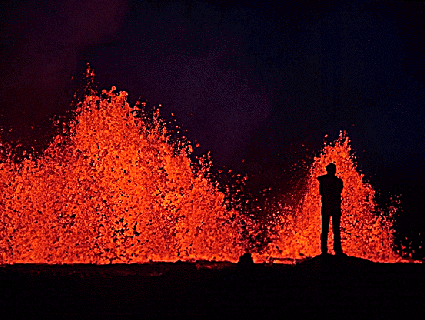
Figure: Fissure eruptions on the island of Iceland.
These are representative of the type of eruptions that created
the Deccan Traps.

THE DECCAN TRAPS/VOLCANISM THEORY
Competing with the "Alvarez hypothesis" is the massive volcanism theory, which places the blame of the extinction on volcanism during the end of the Cretaceous. Main difference between the two theories is: volcanism theory states that the extinction was not instantaneous as predicted by the impact theorists. Volcanism theory is the other end member to the impact theory. The extinctions took place over 1000ís of years. Over a prolonged period, the effects of the volcanism on the biota would be largely similar to that of the meteorite. The only question would be regarding the time frame in which the changes take place.
|
|
Figure: Fissure eruptions on the island of Iceland. These are representative of the type of eruptions that created the Deccan Traps. |
The Cretaceous was a tectonically active time: sea-floor spreading along the Pacific Rim, development of volcanic arcs and Deccan traps. The traps are stacked basalt layers that are spread over 1000's of km in India and are as high as 2000m. Somewhere around 65 Ma, India traveled over the Chagos Archipelago plume (hot spot) on route from Africa to collide with Asia. The plume melted through the Indian craton causing massive volcanism leading to the deposition of the basalt layers that are known as the Deccan Traps. The traps were created over 500,000 years by non-explosive basaltic flows, analogous to modern eruptions in Iceland or Hawaii. The traps cover an area of over 500,000 squared kms. The large scale volcanism caused sulphuric acid, nitrogen, carbon dioxide and other volatiles to be ejected into the atmosphere where they caused climatic changes.
|
|
|
Figure: (Left) The location of the Deccan Traps. (Right) Picture of the stacked basalt layers that are representative of the Deccan Traps.